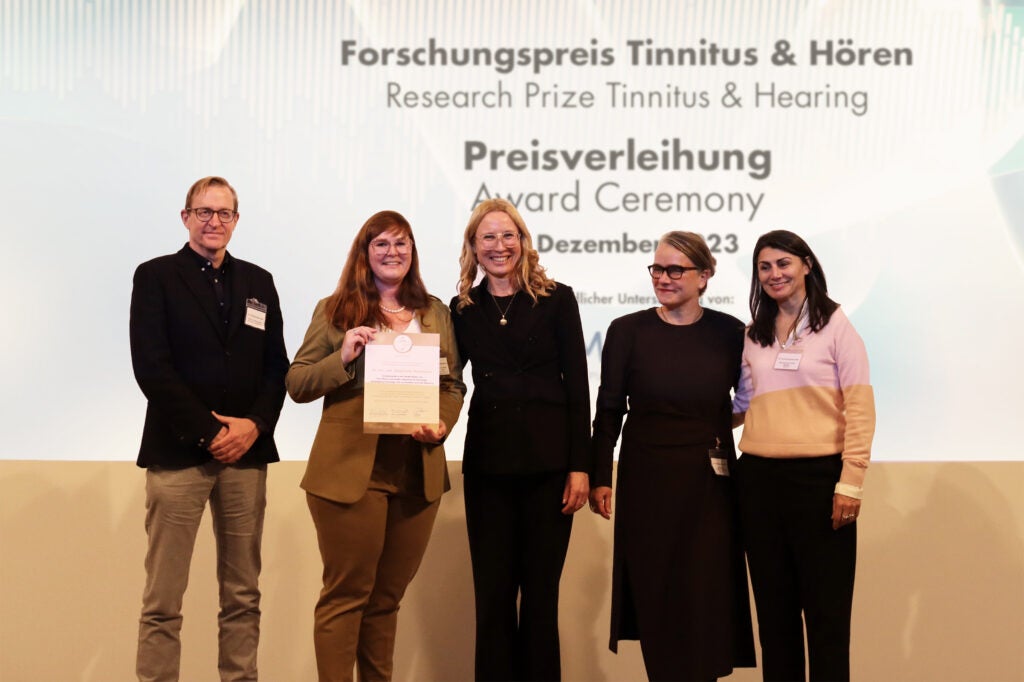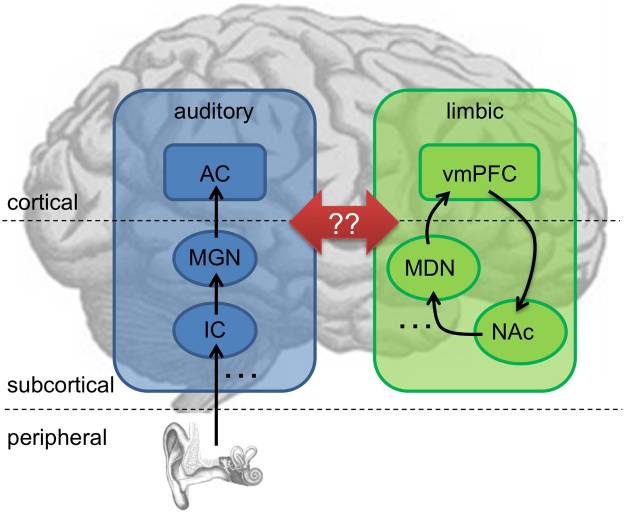TEDx Talk
Interview with Hazel Goedhart from Tinnitus Talk Podcast
Tinnitus and Hearing Research

Rauscheckerlab post-doctoral fellow Stephanie Rosemann, Ph.D. (’20-’22) received the 2023 Tinnitus and Hearing Research Award from the Charité Tinnitus and Hearing Foundation, Berlin, Germany, for her research on “Neural changes in tinnitus – correlation to cognitive performance,” performed in Josef Rauschecker’s Laboratory of Neuroscience and Cognition, Center for Neuroengineering, at Georgetown University.
Featured on the Cover of the journal “Hearing Research”

A schematic model of auditory-limbic interactions in tinnitus
In our model of tinnitus, dysregulation of the auditory system by specific structures of the limbic system is what causes subjective tinnitus to become chronic (see Rauschecker et al., 2010; Leaver et al., 2011). Specifically, peripheral deafferentation of the central auditory pathway (shown in blue) causes increased activity leading to tinnitus via lesion-induced plasticity (Rauschecker, 1999). Typically, transient tinnitus can be assessed by limbic frontostriatal networks (green) as an unwanted and/or irrelevant stimulus (Leaver et al., 2011), and thus suppressed. In patients with chronic tinnitus, this regulatory mechanism does not function properly (Rauschecker et al., 2010): a volume loss is consistently found in the ventromedial prefrontal cortex (vmPFC; Mühlau et al., 2006; Leaver et al., 2011, 2012), and hyperactivity is found in the nucleus accumbens (NAc; Leaver et al., 2011). However, as indicated by the red arrows, exactly how the auditory and limbic networks interact in the context of tinnitus remains to be determined. Studies are sorely needed to test this and other models of tinnitus pathophysiology. Left hemisphere is shown; posterior is on the left; anterior on the right.
Leaver, A. M., Seydell-Greenwald, A., & Rauschecker, J. P. (2016). Auditory-limbic interactions in chronic tinnitus: Challenges for neuroimaging research. In Hearing Research. 334:49-57.
Select Publications
Rauschecker, J. P., Leaver, A. M., & Mühlau, M. (2010). Tuning Out the Noise: Limbic-Auditory Interactions in Tinnitus. In Neuron. 66(6):819-26.
Leaver, A. M., Renier, L., Chevillet, M. A., Morgan, S., Kim, H. J., & Rauschecker, J. P. (2011). Dysregulation of Limbic and Auditory Networks in Tinnitus. Neuron. 69(1):33-43.
Rauschecker, J. P., May, E. S., Maudoux, A., & Ploner, M. (2015). Frontostriatal Gating of Tinnitus and Chronic Pain. In Trends in Cognitive Sciences. (10):567-578.
Leaver, A. M., Seydell-Greenwald, A., & Rauschecker, J. P. (2016). Auditory-limbic interactions in chronic tinnitus: Challenges for neuroimaging research. In Hearing Research. 334:49-57.
Leaver, A. M., Turesky, T. K., Seydell-Greenwald, A., Morgan, S., Kim, H. J., & Rauschecker, J. P. (2016). Intrinsic network activity in tinnitus investigated using functional MRI. Human Brain Mapping, 37: 2717–2735.
Probst, T., Pryss, R. C., Langguth, B., Rauschecker, J. P., Schobel, J., Reichert, M., Spiliopoulou, M., Schlee, W., & Zimmermann, J. (2017). Does tinnitus depend on time-of-day? An ecological momentary assessment study with the “TrackYourTinnitus” Application. Frontiers in Aging Neuroscience, 9:253.
Recent Publications
Rosemann, S., & Rauschecker, J. P. (2023). Increased fiber density of the fornix in patients with chronic tinnitus revealed by diffusion-weighted MRI. Frontiers in Neuroscience, 17.
Rosemann, S., & Rauschecker, J. P. (2023). Disruptions of default mode network and precuneus connectivity associated with cognitive dysfunctions in tinnitus. Scientific Reports, 13(1) 5746
Rosemann, S., & Rauschecker, J. P. (2022). Neuroanatomical alterations in middle frontal gyrus and the precuneus related to tinnitus and tinnitus distress. Hearing Research, 424.
Rogenmoser, L., Kuśmierek, P., Archakov, D., & Rauschecker, J. P. (2022). The blinking eye as a window into tinnitus: A new animal model of tinnitus in the macaque. Hearing Research, 420, 108517

